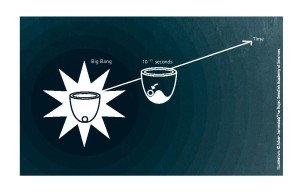For myself, today is perhaps a highlight day for this year’s Nobel Prize – it is time for the Physics prize, and that perhaps betrays a slight bias on my part, because the other categories are just as appropriate (apart from “peace”, but I’ll save that rant until later in the week).
So why is Physics a highlight? Well perhaps that was best expressed by Ernest Rutherford who in 1962 is quoted as saying, “All science is either physics or stamp collecting“. Now, what is a truly delicious bit of irony here is that Rutherford himself won the Nobel Prize, but not for physics, he was awarded the prize for Chemistry in 1908 “for his investigations into the disintegration of the elements, and the chemistry of radioactive substances”.
I do however get his point, and so it is that same thought that perhaps makes this one a highlight. Physics is indeed the study of reality itself and so not only does it often explain the fundamental mechanisms of other sciences, but does also open new avenues of research into areas such as mathematics and even philosophy.
It is also rather reassuring to look down the list of Physics winners are see that it is (as should be expected) a collection of well-known names, and with good reason, for these are the people who have greatly expanded our understanding of reality …
To pick a few at random … Marie Curie, Max Planck, Albert Einstein, Niels Bohr, Werner Heisenberg, Erwin Schrödinger (yes the guy with the cat); Paul Dirac, Enrico Fermi, Wolfgang Pauli, Richard Feynman, Hans Bethe, Steven Weinberg. If you honestly have no idea who they are, why not pick a couple, click the link and see what made them famous.
So anyway, enough of my babbling – Time to cue the drum roll …
Direct from the Nobel Committee themselves …
The Royal Swedish Academy of Sciences has decided to award the Nobel Prize in Physics for 2013 to
François Englert
Université Libre de Bruxelles, Brussels, Belgium
and
Peter W. Higgs
University of Edinburgh, UK
“for the theoretical discovery of a mechanism that contributes to our understanding of the origin of mass of subatomic particles, and which recently was confirmed through the discovery of the predicted fundamental particle, by the ATLAS and CMS experiments at CERN’s Large Hadron Collider”
Here, at last!
François Englert and Peter W. Higgs are jointly awarded the Nobel Prize in Physics 2013 for the theory of how particles acquire mass. In 1964, they proposed the theory independently of each other (Englert together with his now deceased colleague Robert Brout). In 2012, their ideas were confirmed by the discovery of a so called Higgs particle at the CERN laboratory outside Geneva in Switzerland..
The awarded theory is a central part of the Standard Model of particle physics that describes how the world is constructed. According to the Standard Model, everything, from flowers and people to stars and planets, consists of just a few building blocks: matter particles. These particles are governed by forces mediated by force particles that make sure everything works as it should.
The entire Standard Model also rests on the existence of a special kind of particle: the Higgs particle. This particle originates from an invisible field that fills up all space. Even when the universe seems empty this field is there. Without it, we would not exist, because it is from contact with the field that particles acquire mass. The theory proposed by Englert and Higgs describes this process.
On 4 July 2012, at the CERN laboratory for particle physics, the theory was confirmed by the discovery of a Higgs particle. CERN’s particle collider, LHC (Large Hadron Collider), is probably the largest and the most complex machine ever constructed by humans. Two research groups of some 3,000 scientists each, ATLAS and CMS, managed to extract the Higgs particle from billions of particle collisions in the LHC.
Even though it is a great achievement to have found the Higgs particle — the missing piece in the Standard Model puzzle — the Standard Model is not the final piece in the cosmic puzzle. One of the reasons for this is that the Standard Model treats certain particles, neutrinos, as being virtually massless, whereas recent studies show that they actually do have mass. Another reason is that the model only describes visible matter, which only accounts for one fifth of all matter in the cosmos. To find the mysterious dark matter is one of the objectives as scientists continue the chase of unknown particles at CERN.
François Englert, Belgian citizen. Born 1932 in Etterbeek, Belgium. Ph.D. 1959 from Université Libre de Bruxelles, Brussels, Belgium. Professor Emeritus at Université Libre de Bruxelles, Brussels, Belgium.
www.ulb.ac.be/sciences/physth/people_FEnglert.html
Peter W. Higgs, UK citizen. Born 1929 in Newcastle upon Tyne, UK. Ph.D. 1954 from King’s College, University of London, UK. Professor emeritus at University of Edinburgh, UK.
www.ph.ed.ac.uk/higgs/

